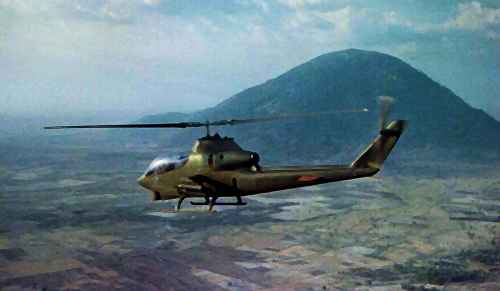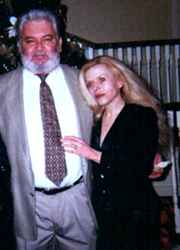|
|
SHITFIRE
Cobra Aircraft "66-15340"
I was delighted the day I became an Aircraft Commander for the first time, over there inside South Vietnam, because after that day, my name was painted boldly on the side of my very own Cobra gunship. It didn't matter that she was the oldest, beat up ole hog in our entire company of twelve ships. She was lighter than the newer models -- so she could lift more weight. When I got her she had already flown a thousand hours of hard combat. The painted color of her skin was darker in shade than any other aircraft within our Company or anywhere over there. She stood out. Old and battered she was. The weapons system on board her were different as well. On her short stubby wings rode two, Air Force pod type, mini-guns with six spinning barrels. These weapons had nearly zero jamming difficulties which differed greatly from the Army version linked ammo type that quit far to often. I had an Army version in the nose turret so she had three mini-guns that could shoot twelve thousand bullets a minute. Fifty-eight seventeen pound rockets and a canister of three hundred grenades that I could fire in one minute. Death on skids she was clearly.
I'd heard a whispering voice from her as I approached the first time as her new aircraft commander, "Lets go get'em."
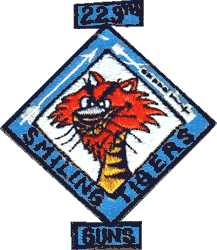 My official call sign was "Smiling Tiger -- Three-Four" and my Cobra's last three numbers were very similar at three-four-zero. My real call sign was "Shitfire" which matched her perfectly. That machine had bullet hole patches over her bullet hole patches which were scattered through out her thin aluminum skull. The further one looked back toward the tail rotor the more common those bright pea green bullet hole patches appeared. I once counted seventy-five patches just in the far rear tailboom alone. It was so noticeable in the tailboom area that tower operators around South Vietnam would comment about it when I was refueling or rearming.
My official call sign was "Smiling Tiger -- Three-Four" and my Cobra's last three numbers were very similar at three-four-zero. My real call sign was "Shitfire" which matched her perfectly. That machine had bullet hole patches over her bullet hole patches which were scattered through out her thin aluminum skull. The further one looked back toward the tail rotor the more common those bright pea green bullet hole patches appeared. I once counted seventy-five patches just in the far rear tailboom alone. It was so noticeable in the tailboom area that tower operators around South Vietnam would comment about it when I was refueling or rearming.
She, also, had a landing light located up front in her nose cone, that those newer birds from America didn't have any longer. I felt I needed that light as a security blanket and used it often during my long and scary night flights. Three-four-zero carried me most of the way through my first 365 days in South Vietnam. Later as I grew more dominate in our company I was offered newer aircraft, complete with air conditioning, which I always turned down.
I flew her during my stay there until I couldn't fly her any longer. It wasn't her fault. No sir. I'd loved that ole bucket of bent bolts. She'd stayed under me when I'd received my Distinguished Flying Cross. She'd taken me with little fuss through lightning strikes, poor takeoffs, difficult landings and the overblown dangers about which most human beings cannot fathom.
|
|
Cursing her was a daily event. Loving her strongly with full human emotion was an hourly happening. I spoke to that grand ole lady as if she were my living and breathing wife from hell. She was more than just "something" to this ole country boy. Breathing fire was her heartbeat as she rolled over in flight as if she wanted me to rub her belly.
No matter what happened -- she never refused my advances. She always returned us pitiful crewmembers to a friendly base even though she was often crippled and tired of our senseless fighting. There were times when that danged thing got so cranky that I had to inform her specifically that I was boss. I was king here baby.
That ole bird gave me some hard time bitching but somehow through multicolored trailing rows of smoke she'd bring us back. She'd limp, lean over, whine and grind out a mechanical song of pining as if her battle damages were going to win this time. Those loud banging sounds outside that clashed with the relative wind mixed along with flashing Christmas tree warning lights on my dash of assorted rainbow colors didn't help much either. Those lights were always accompanied by loud horns honking in my headset trying disparately to get my overloaded attention. We two crewmembers on at least one weekly adventure caused us to sweat blood all the way home. That was her way when I flew her and that's what really counted to me in combat. We were scared to death in her cockpit but all the while she'd be just as calm as a woman can be at being caught off guard. She "WAS" my best buddy.
I often went down on our days off to help my crew chief, wash and wax her. It didn't help much. She was still the ugliest insect circling the light bulb. She knew it, too. But I refused to give up on my name sake bird.
I'm sure the enemy trembled when we as a team arrived on their scene. Two bonded systems, mechanical flesh and bone, arriving to hand our very capable enemy a triple hard time with sledge hammer deluxe.
|
|
On her final day of fighting in my company, while in heavy combat, a large enemy bullet pierced her exactly where my name was painted on her outside skin. That shell entered her at a forty-five degree angle, upward, all the while cutting large electrical cables as big as one's arm that ran to and fro from her cockpit to the engine compartment behind the cockpit.
That cockpit filled with heavy smoke as fast as one could say "Jack Frost" and then just as suddenly she lost her electrical soul. As usual she didn't care much about minor difficulties and managed to bring her crew home safely, once again. Upon her return to our company the mechanics and operations officers argued about what to do with her. Our futures would soon part forever because it would take nine hundred man hours of manual labor to fix her electrical system. Our maintenance department decided to send her off to some distant peaceful place to get repaired.
|
|
I was miserable. So was my crew chief. We both kept an insignificant piece of her to honor her loyalty and her great sacrifices made to us. Maintenance hooked her up to a sling as I stood and watched. A Chinook helicopter arriving from Saigon with tow cables ready showed its face. The Chinook was going to haul HER away from me. "Smiling Tiger Three-Four-Zero" had a medical discharge from D-229th, The First Cavalry Division.
|
|
My crew chief and I stood together as they hooked her up and left with her twisting fitfully under their belly. She faded off into the Eastern horizon. We had tears rolling down our grimy faces. As we looked at each other we saw the others war weary face with trails of clear running down the, reddish, dirt war mask of the other.
Then without choice I flew in air conditioned comfort and thought about those good old days when I used to sweat inside my favorite combat ride. War just wasn't the same with air conditioning. A man should be forced to sweat while killing other human beings.
I found out decades later that the Army had fixed 66-15340 and sent her back into combat. She went further north that time than where I'd been fighting the enemy in 1969.
There are two names on the Washington D. C. Vietnam War Memorial that died inside her. She was destroyed at the same time as they. Warrant Officer 1, James Lee Paul the aircraft commander and WO 1 Carl Mitchell Wood took her to where no one could survive -- not even a machine.
My dream ship had fought until there was no fight left in her. Now her metal bones, too, are strewn across a forgotten battlefield in Vietnam.
|
|
POST SCRIPT
I sent you this tale about my Cobra and the other two pilots to give other American's the feelings I had and still have for this lovely old war horse. If you can display this once proud machine so her memory won't die then go do it. I am seeking neither fame nor fortune but simply a continuation of my admiration for this aircraft inside D-229th, The First Cavalry Division in 1969.
The two young men that died later inside her must have a record said also. I'm just an outside observer to these three great warriors and nothing more. Writing this brief war chest was an honor to them all. Three Four Zero was their final obituary.
The aircraft commander's (WO-1 James Lee Paul) body was never recovered. BNR is the military term used in his case. Only one of the three, human & aircraft's, bodies (WO-1 Carl Mitchell Wood) does not lay in Vietnam. He was officially "KIA." Unless something recent has changed that I'm not aware of as yet. Then the above is absolute fact as far as I've been made aware. :KRW
|
|
|
|
|
|
Kenneth Ray Whitley
©October 2000
Two Complete Tours in 'Nam
December 1968 - December 1969
January 1972 - January 1973
Helicopter Pilot
| Previous Page |
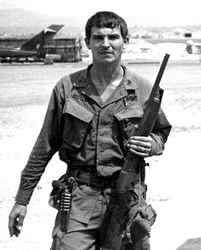
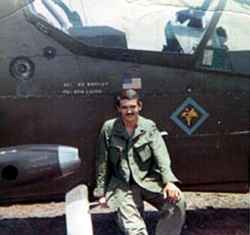
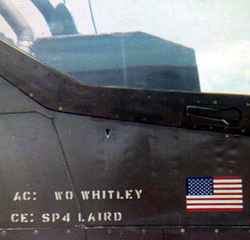
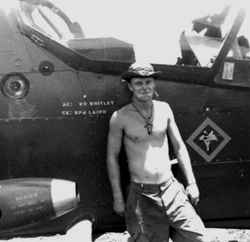
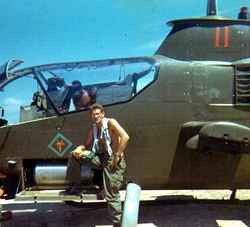 This is Stockstill, the guy that I shed tears with when Cobra 340 left D-229th Company in the fall of 1969. I found out years later that he'd committed suicide. It really upset me. He took all his clothes off late one night folding them neatly beside the road along with his socks and shoes. When an eighteen wheeler truck heading west, on Interstate 20 near Gordon, Texas, came by, he ran out at the last second and insured his quick death. I feel personally that he had Post Traumatic Stress Disorder from the war and simply couldn't live with himself any longer. Dau Teing, South Vietnam, wasn't a nice place to visit much less live in for a year. I later went to his cemetery and shed tears over him but it was much too late. I've always felt guilt since that I hadn't reached out to him early enough. I blame myself for his death and always will. It takes combat buddies to truly understand these issues as you probably well know
This is Stockstill, the guy that I shed tears with when Cobra 340 left D-229th Company in the fall of 1969. I found out years later that he'd committed suicide. It really upset me. He took all his clothes off late one night folding them neatly beside the road along with his socks and shoes. When an eighteen wheeler truck heading west, on Interstate 20 near Gordon, Texas, came by, he ran out at the last second and insured his quick death. I feel personally that he had Post Traumatic Stress Disorder from the war and simply couldn't live with himself any longer. Dau Teing, South Vietnam, wasn't a nice place to visit much less live in for a year. I later went to his cemetery and shed tears over him but it was much too late. I've always felt guilt since that I hadn't reached out to him early enough. I blame myself for his death and always will. It takes combat buddies to truly understand these issues as you probably well know